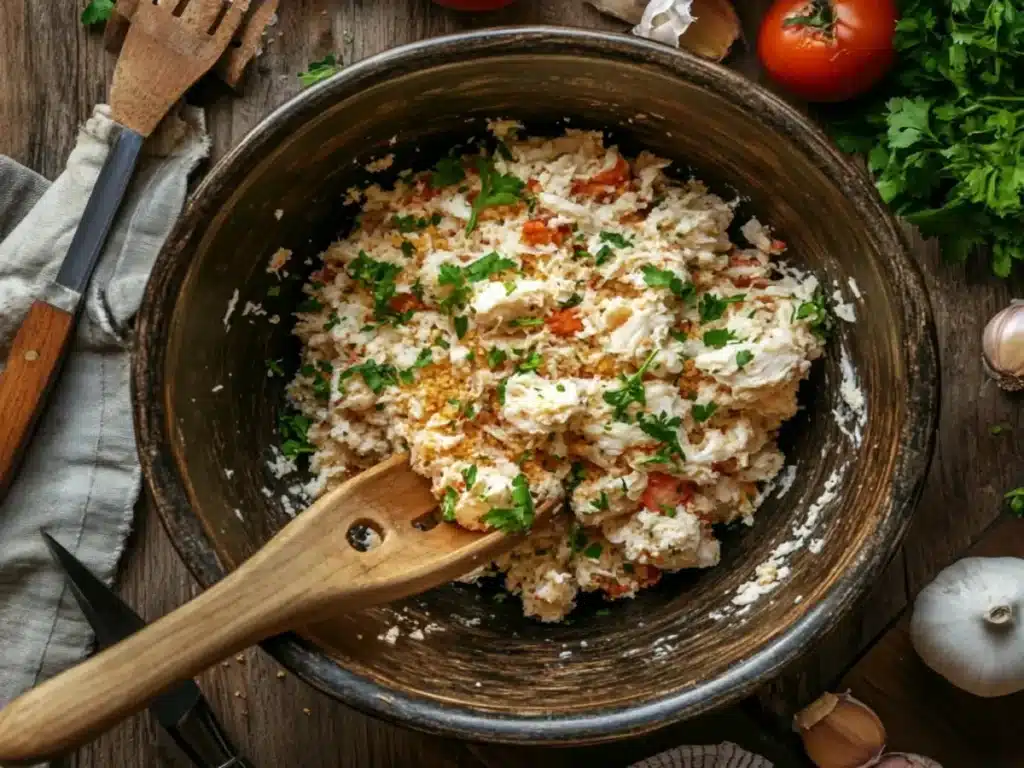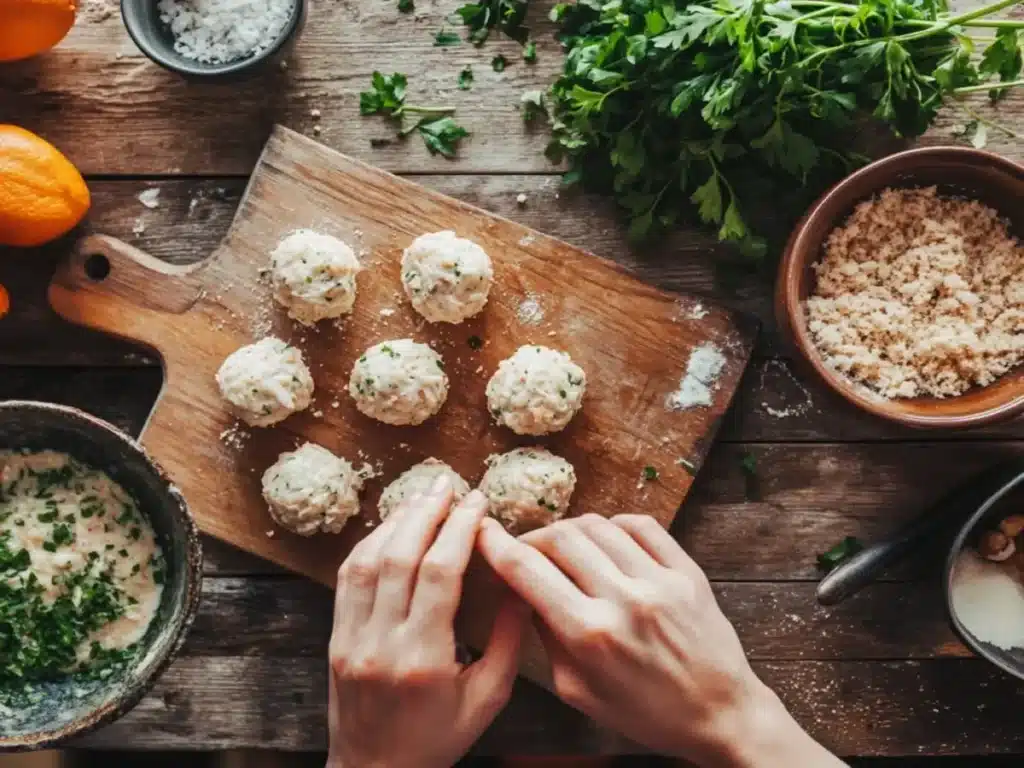The Ultimate Crab Balls Recipe is a crowd-pleasing favorite, known for its rich crab meat, flavorful spices, and crispy, golden crust. These bite-sized delights are perfect for any occasion—whether it’s a casual family meal or a party appetizer. With their easy preparation and irresistible taste, this recipe has become a staple for seafood lovers everywhere.
What makes crab balls special is how they highlight the natural sweetness of crab meat while blending tasty flavors and textures. They’re crispy on the outside, soft and savory inside, and surprisingly easy to whip up at home. In this guide, we’ll show you how to make them step by step, from picking the freshest ingredients to serving them with the best dips.
Whether you’re an experienced cook or just trying seafood recipes for the first time, this guide will make it simple and fun. Put on your apron, and let’s get started!
Table of contents
Ingredients and Preparation Steps for the Ultimate Crab Balls Recipe
Essential Ingredients
For more insights on dessert recipes, explore our guide on The Best Cream for Cream Brulee.
To create crab balls that burst with flavor, you’ll need:
- Fresh Crab Meat (1 lb): Fresh lump crab meat works best for its sweet, tender texture. If unavailable, high-quality canned crab meat is a reliable alternative.
- Breadcrumbs (1/2 cup): Panko breadcrumbs provide a light, crispy texture, but regular breadcrumbs also work.
- Egg (1 large): Acts as a binding agent to hold the mixture together.
- Mayonnaise (1/4 cup): Adds creaminess and enhances the flavor.
- Dijon Mustard (1 tsp): Adds a tangy kick to the mixture.
- Seasonings:Old Bay seasoning (1 tbsp): Essential for a classic seafood flavor.
- Garlic powder (1 tsp)
- Paprika (1/2 tsp)
- Salt and pepper to taste
- Fresh Herbs:Parsley (2 tbsp, finely chopped): Provides freshness and color.
- Lemon Juice (1 tbsp): Brightens the overall flavor profile.
Preparation Steps

- Prepare the Crab Meat Start by checking the crab meat for any shell pieces and removing them. Then, pat it dry with a paper towel to get rid of extra moisture, which helps the mixture hold together.
- Mix the Ingredients In a large mixing bowl, combine the crab meat, breadcrumbs, egg, mayonnaise, Dijon mustard, parsley, lemon juice, and seasonings. Use a spatula or your hands to mix gently. Overmixing can break the delicate crab meat, so keep it light.
- Shape the Crab Balls Once the mixture is combined, use a small scoop or your hands to shape the mixture into golf ball-sized portions. Place them on a parchment-lined baking sheet. Aim for uniform sizes to ensure even cooking.
- Chill the Mixture Chill the crab balls in the refrigerator for at least 30 minutes. This step helps them firm up and hold their shape during cooking.
Cooking and Serving Instructions for the Ultimate Crab Balls Recipe
Frying the Crab Balls
- Heat vegetable oil in a deep skillet or fryer to 350°F. Use enough oil to submerge the crab balls halfway.
- Fry the crab balls in small batches, ensuring they have space to cook evenly. Turn occasionally with a slotted spoon or tongs for an even golden-brown exterior. Each batch should take 3-5 minutes.
- Remove the cooked crab balls and place them on a plate lined with paper towels to drain excess oil.
Baking Option for the Ultimate Crab Balls Recipe
For a healthier option, bake the crab balls:
- Preheat your oven to 375°F.
- Arrange the chilled crab balls on a greased or parchment-lined baking sheet.
- Lightly spray the tops with cooking spray for added crispiness.
- Bake for 15-20 minutes, flipping halfway through, until golden brown.
Serving Suggestions
Crab balls shine when paired with complementary dips and sides. Here are some ideas:
- Dipping Sauces: Serve with tartar sauce, spicy sriracha mayo, or garlic aioli.
- Side Dishes: Pair with a crisp green salad, coleslaw, or roasted vegetables for a balanced meal.
- Presentation Tips: Garnish with a sprinkle of parsley and a wedge of lemon for a restaurant-worthy finish.
Storage and Reheating Tips for the Ultimate Crab Balls Recipe

If desserts are your passion, don’t miss the Secret to Perfect Cream Brulee to refine your culinary expertise.
Proper Storage
Keep leftover crab balls in a sealed container in the fridge for up to three days to stay fresh and avoid picking up other flavors.
Freezing Instructions
To freeze uncooked crab balls:
- Place them on a baking sheet in a single layer and freeze until solid.
- Transfer the frozen crab balls to a resealable freezer bag. Label and date the bag for easy reference.
- Frozen crab balls can be cooked directly from the freezer; just add a few extra minutes to the cooking time.
Reheating Tips
For crispy reheated crab balls:
- Use an oven or air fryer at 350°F for 5-7 minutes, ensuring even warming.
- Avoid microwaving as it can make the exterior soggy.
Storage and Reheating Tips
Proper Storage for the Ultimate Crab Balls Recipe
Store leftover crab balls in an airtight container in the refrigerator for up to three days. This prevents them from absorbing other flavors and maintains their freshness.
Freezing Instructions
To freeze uncooked crab balls:
- Place them on a baking sheet in a single layer and freeze until solid.
- Transfer the frozen crab balls to a resealable freezer bag. Label and date the bag for easy reference.
- Frozen crab balls can be cooked directly from the freezer; just add a few extra minutes to the cooking time.
Reheating Tips
For crispy reheated crab balls:
- Use an oven or air fryer at 350°F for 5-7 minutes, ensuring even warming.
- Avoid microwaving as it can make the exterior soggy.
Nutritional Insights and Variations
Nutritional Breakdown
A standard serving of crab balls contains approximately:
- Calories: 90-100 per piece (depending on size and frying method)
- Protein: 6-8 grams
- Fat: 4-6 grams
- Carbohydrates: 5-7 grams
These values make crab balls a protein-rich appetizer that can fit into most balanced diets. For lighter options, consider baking instead of frying.
Recipe Variations for the Ultimate Crab Balls Recipe
- Spicy Kick: Add finely chopped jalapeños or a dash of cayenne pepper for a fiery twist.
- Gluten-Free: Replace breadcrumbs with almond flour or gluten-free panko.
- Herbaceous Flavor: Incorporate dill or chives alongside parsley for a fresh, herbal taste.
Cultural Background and History
Origins of crab balls in coastal cuisines
Crab balls trace their roots to coastal cuisines, where fresh seafood plays a central role in daily life. For example, in regions like the Chesapeake Bay area, where blue crabs are plentiful, they emerged as a creative way to use crab meat. Over time, they became a popular dish at community gatherings and celebrations, highlighting the local bounty and bringing people together.
Regional influences and ingredient adaptations
The simplicity of the dish—requiring only a handful of ingredients—allowed it to spread across different cultures and regions. Over time, variations emerged, incorporating spices and techniques unique to each locality. For example, in Maryland, Old Bay seasoning became a staple ingredient, while other coastal areas infused their crab balls with tropical flavors like coconut and lime.
Modern-day popularity and global appeal
Today, crab balls remain a beloved dish worldwide. They’re featured in everything from street food stalls to fine dining establishments, a testament to their universal appeal. Whether you’re enjoying them at a beachside shack or making them at home, crab balls carry with them a rich history of tradition and flavor.
Pairing Recommendations for the Ultimate Crab Balls Recipe
Beverage Pairings for the Ultimate Crab Balls Recipe
The flavors of crab balls pair beautifully with crisp, refreshing beverages. Consider these options:
- White Wine: A dry Sauvignon Blanc or Pinot Grigio complements the delicate sweetness of the crab meat.
- Beer: Light, hoppy beers like pale ales or lagers are great for balancing the richness of the crab balls.
- Cocktails: Classic cocktails like mojitos or margaritas add a zesty, citrusy contrast to the dish.
Side Pairings for the Ultimate Crab Balls Recipe
- Vegetables: Grilled asparagus or roasted brussels sprouts bring a smoky, earthy balance to the seafood.
- Starches: Serve with warm garlic bread or creamy mashed potatoes for a hearty accompaniment.
- Salads: A tangy arugula salad with a citrus vinaigrette enhances the dish’s freshness.
Common Mistakes and How to Avoid Them
Overmixing the Crab Mixture
A common mistake is overmixing the crab meat, which ruins its delicate texture. Gently mix the ingredients to keep the meat intact.
Skipping the Chilling Step
Skipping the chilling process can lead to crab balls falling apart during cooking. Refrigerating them for at least 30 minutes helps them firm up and hold their shape.
Using Low-Quality Crab Meat
The quality of the crab meat directly affects the flavor of the dish. Always opt for fresh or high-quality canned crab meat for the best results.
Cooking at the Wrong Temperature
Cooking at too high a heat can burn the outside while leaving the inside undercooked. Use a thermometer to keep the oil at 350°F for frying or stick to the recommended oven temperature for baking.
Sustainability and Ethical Sourcing of Crab Meat
Importance of sustainable seafood practices
Seafood lovers should think about the sustainability of the ingredients they use. Overfishing and habitat loss have strained crab populations in some areas, so choosing responsibly sourced crab is key to protecting marine ecosystems.
Certifications to look for when purchasing crab meat
When buying crab meat, look for certifications like Marine Stewardship Council (MSC) or Aquaculture Stewardship Council (ASC). These labels ensure that the seafood comes from well-managed fisheries or sustainable aquaculture practices. Supporting local fisheries is another way to ensure ethical sourcing while boosting local economies.
Avoid purchasing crab meat during its breeding season to allow populations to replenish naturally. If fresh crab isn’t available, high-quality frozen or canned alternatives from reputable brands are excellent options.
Environmental impact and supporting local fisheries
By choosing sustainable crab meat, you’re not only protecting the environment but also ensuring future generations can enjoy dishes like crab balls. Remember, every small decision counts toward a healthier planet.
FAQs
Can I Make Crab Balls with Imitation Crab Meat?
Yes, you can use imitation crab meat, but the texture and flavor will be different. Fresh or canned lump crab meat is recommended for the best taste. If using imitation crab, chop it finely and mix it well with seasonings to enhance its flavor.
What’s the Best Way to Store Leftover Crab Balls?
Store leftover crab balls in an airtight container in the refrigerator for up to 3 days. To maintain freshness, place them on a paper towel to absorb excess moisture.
How Do You Freeze Crab Balls for Later?
To freeze uncooked crab balls:
Arrange them on a baking sheet in a single layer and freeze until solid.
Transfer them to a freezer-safe bag or container and label with the date.
Cook from frozen by adding a few extra minutes to the cooking time.
How Can I Make Gluten-Free Crab Balls?
To make gluten-free crab balls, replace breadcrumbs with gluten-free panko, almond flour, or crushed gluten-free crackers. Ensure all seasonings and condiments (like mustard and mayo) are gluten-free.
Which Oil is Best for Frying Crab Balls?
Use neutral oils with a high smoke point such as vegetable oil, canola oil, or peanut oil. These oils help achieve a crispy, golden crust without overpowering the crab’s natural flavor.
How Far in Advance Can I Prepare Crab Balls?
You can prepare crab balls up to 24 hours in advance before cooking. Keep them refrigerated on a parchment-lined tray, covered tightly with plastic wrap. Chilling them also helps them hold their shape better when cooking.
How Do You Reheat Crab Balls Without Losing Crispiness?
The best way to reheat crab balls while keeping them crispy is to use an oven or air fryer:
Oven: Preheat to 350°F (175°C) and bake for 5-7 minutes.
Air Fryer: Heat at 350°F for 3-5 minutes until warm and crispy.
❌ Avoid microwaving, as it can make the exterior soggy.
Conclusion
Making crab balls at home is a rewarding experience that combines ease and delicious results. Whether fried or baked, these bite-sized seafood delights are sure to impress family and friends. With a crispy exterior, tender interior, and rich flavor, this recipe guarantees satisfaction every time. So, roll up your sleeves, gather your ingredients, and enjoy the process of creating the ultimate crab balls
